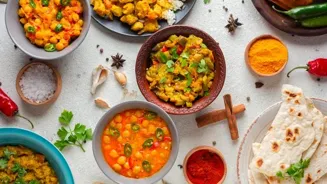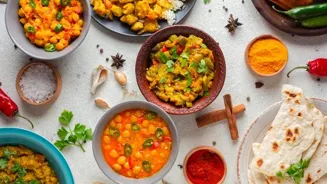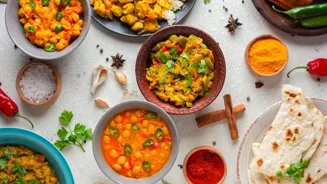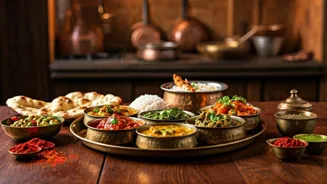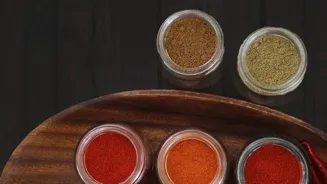Unravel the secrets of mastering Masala Dosa! Discover 8 expert tips to perfect this iconic South Indian dish at home
Ah, the Masala Dosa! That crispy, golden-brown pancake, filled with a flavourful potato
masala, is a South Indian culinary icon! From the bustling streets of Chennai to the cozy corners of Bangalore homes, this dish reigns supreme.
But, achieving the perfect Masala Dosa is an art, a delicate balance of technique and patience. Are you also dreaming of making the perfect Masala Dosa? Don't worry; we've got you covered. This guide will help you step by step so that you can nail this classic dish in your own kitchen!
Perfect dosa batter: key is soaking, grinding, and fermentation
First, let's talk about the batter - the very foundation of your Masala Dosa. The batter needs to be just right. It can't be too thick, or your dosa will be dense and heavy. Too thin, and it'll tear apart on the tawa. The ideal batter should have a smooth, flowing consistency, similar to buttermilk.
Achieving this is all about the soaking and grinding process. Use good quality urad dal and rice. Soak them separately for at least 4-5 hours, or even overnight, for best results. This helps the grains soften, making it easier to grind them into a fine paste.
Do not get lazy during the soaking as the more you soak, the better the batter. When grinding, add water gradually, little by little, until you get the desired consistency. Once ground, the batter needs to ferment properly for at least 8-10 hours, or even longer in colder climates.
Fermentation is what gives the dosa its signature tangy flavour and light, airy texture. As the batter sits, it starts bubbling, and you'll notice it increasing in volume. Don’t rush this part, as fermentation is the key to a good dosa.
Seasoned tawa is crucial for crispy dosas
Next comes the tawa – the stage where the magic happens! The tawa needs to be properly seasoned and heated to the right temperature. The ideal tawa for dosa making is a well-seasoned cast iron griddle. Heat it over medium-high heat. To check if the tawa is ready, sprinkle a few drops of water on it.
If the water sizzles and evaporates quickly, it's ready. If the water sits on the surface, it's not hot enough and if it splatters violently, then it is too hot. Before pouring the batter, lightly grease the tawa with oil.
Use a small bowl dipped in oil and rub it on the tawa to avoid it sticking together. This will prevent the dosa from sticking and help it crisp up beautifully. Now, for the pouring! Use a ladle to pour a spoonful of batter onto the center of the hot tawa.
With the back of the ladle, gently spread the batter in a circular motion, moving from the center outwards. Try to make it as thin and even as possible. The thinner the dosa, the crispier it will be. Don't worry if the dosa has a few holes – it adds to its rustic charm!
Achieving perfect dosa: control heat, use oil, flip when golden
Now, let’s discuss achieving that even, golden-brown colour. This is all about controlling the heat and using the right amount of oil. Once you've poured and spread the batter, drizzle a teaspoon of oil around the edges of the dosa.
This will help it crisp up and prevent it from sticking to the tawa. Keep the heat at medium-high and let the dosa cook for a minute or two, until the bottom turns golden brown. You'll see the edges starting to lift and the surface becoming less sticky. This is a sign that it's ready to flip.
Use a thin, flat spatula to gently loosen the edges of the dosa and then carefully flip it over. Cook the other side for another minute or two, until it's also golden brown and crispy. Keep a close eye on the dosa, and adjust the heat as needed to prevent it from burning.
The colour and texture will tell you if it is cooked well!
Potato masala elevates dosa; secret recipes key
And now, the star of the show: the Masala! The potato masala is what truly elevates the humble dosa into a Masala Dosa experience, and every household has its own secret recipe and special touch!
But the base is generally the same: boiled potatoes tempered with mustard seeds, curry leaves, onions, and a blend of spices. For the perfect masala, start by boiling the potatoes until they are soft and easily mashable. While they are boiling, prepare the tempering.
Heat oil in a pan and add mustard seeds. When the mustard seeds start to splutter, add curry leaves, chopped onions. Sauté until the onions are golden brown. Once you’ve made the masala, set everything aside, because the fun part is about to begin!
Making sure you have the masala prepared before hand, makes things easier. This ensures that your only focus is on creating the perfect dosa.
Fold dosa with masala, serve with sambar & chutney, enjoy!
Let's consider folding and serving. Once your dosa is cooked to perfection, it's time to add the masala and fold it into that iconic triangle or roll. Take a generous spoonful of the potato masala and spread it evenly over one half of the dosa.
Using your spatula, gently fold the dosa over the filling. You can fold it into a half-moon shape, or roll it up like a burrito. The choice is yours! Now, for the all-important accompaniments! Masala Dosa is traditionally served with sambar and coconut chutney.
Sambar is a flavorful lentil-based vegetable stew, and coconut chutney is a creamy, tangy dip made from grated coconut, green chilies, and spices. These accompaniments complement the dosa perfectly, adding layers of flavour and texture to the dish.
Serve your Masala Dosa hot off the tawa, with generous portions of sambar and coconut chutney. Garnish with a sprig of fresh coriander leaves for added freshness.
Tips for perfect dosas: troubleshoot sticking, tearing, lack of crispiness. Adjust tawa heat, batter consistency, oil amount
Finally, let's talk about addressing some common dosa dilemmas like: sticking, tearing, not being crispy. A sticky dosa usually means the tawa isn't hot enough or it's not properly seasoned. Make sure the tawa is heated to the correct temperature before pouring the batter.
If it's too hot, you need to let it cool down slightly. If it's too cold, you need to let it heat up accordingly. Sprinkle water to lower it down if it seems too hot. A tearing dosa indicates that the batter is too thin or the tawa is too rough.
Adjust the batter consistency by adding a little bit of rice flour or urad dal flour. A not-so-crispy dosa can be fixed by using more oil while cooking and ensuring the dosa is spread thinly enough. Remember, practice makes perfect!
Don't be disheartened if your first few dosas aren't picture-perfect. With a little bit of patience and perseverance, you'll be whipping up crispy, golden-brown Masala Dosas in no time! So, gather your ingredients, fire up the tawa, and get ready to embark on a Masala Dosa adventure.

